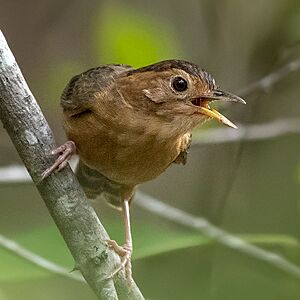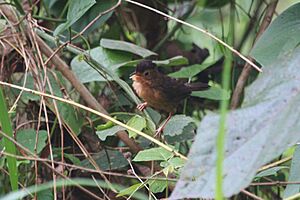Brown-capped babbler facts for kids
Quick facts for kids Brown-capped babbler |
|
|---|---|
 |
|
| Conservation status | |
| Scientific classification | |
| Genus: |
Pellorneum
|
| Species: |
fuscocapillus
|
The brown-capped babbler is a small, interesting bird. It belongs to a bird family called Pellorneidae. This bird is special because it lives only in Sri Lanka.
Contents
Where Does It Live?
The brown-capped babbler lives only in Sri Lanka. This means it is an endemic bird there. It likes to live in the thick plants under trees in forests. It also enjoys bushy areas. Unlike many birds, it does not fly to different places for seasons. It stays in Sri Lanka all year. This bird has short, round wings. It does not fly very strongly.
Its Home and Food
This babbler builds its nest on the ground. Sometimes it uses a hole hidden in thick leaves. A female brown-capped babbler usually lays two or three eggs. These birds mainly eat insects.
What Does It Look Like?
The brown-capped babbler is a small to medium-sized bird. It is about 16 centimeters (6.3 inches) long, including its tail. Its back is brown, and its belly is a rich cinnamon color. It has a dark brown cap on its head.
These birds have short, dark beaks. It can be hard to see them because they hide in thick plants. But like other babblers, they are noisy birds. Their special calls often help people know they are nearby.
How Does It Behave?
Brown-capped babblers usually live in pairs. Male birds make a special call that sounds like "pretty dear." This call helps them attract other birds. They breed during the first half of the year. During this time, male birds protect their territory.
In Sri Lankan Culture
In Sri Lanka, this bird has two local names. One is parandel-kurulla, which means 'dried-grass-colored bird'. The other name is redi diang. This name sounds like the bird's call. The brown-capped babbler even appears on a 4 rupee Sri Lankan postal stamp.
Different Kinds of Brown-Capped Babblers
There are three slightly different types, or subspecies, of the brown-capped babbler:
- P. f. babaulti - found in the dry lowlands.
- P. f. fuscocapillus - lives in the hill country.
- P. f. scotillum - found in the wet lowlands.



